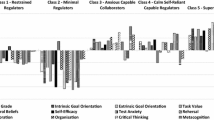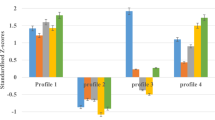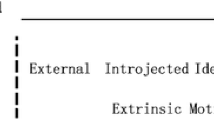Abstract
The goal of the present study was to utilize a profiling approach to understand differences in motivation and strategic self-regulation among post-secondary STEM students in major versus required non-major computer science courses. Participants were 233 students from required introductory computer science courses (194 men; 35 women; 4 unknown) at a large Midwestern state university. Cluster analysis identified five profiles: (1) a strategic profile of a highly motivated by-any-means good strategy user; (2) a knowledge-building profile of an intrinsically motivated autonomous, mastery-oriented student; (3) a surface learning profile of a utility motivated minimally engaged student; (4) an apathetic profile of an amotivational disengaged student; and (5) a learned helpless profile of a motivated but unable to effectively self-regulate student. Among CS majors and students in courses in their major field, the strategic and knowledge-building profiles were the most prevalent. Among non-CS majors and students in required non-major courses, the learned helpless, surface learning, and apathetic profiles were the most prevalent. Students in the strategic and knowledge-building profiles had significantly higher retention of computational thinking knowledge than students in other profiles. Students in the apathetic and surface learning profiles saw little instrumentality of the course for their future academic and career objectives. Findings show that students in STEM fields taking required computer science courses exhibit the same constellation of motivated strategic self-regulation profiles found in other post-secondary and K-12 settings.
Similar content being viewed by others
References
Ainley M (1993) Styles of engagement with learning: multidimensional assessment of their relationship with strategy use and school achievement. J Educ Psychol 3:395–405
Ames CA (1992) Classrooms: goals, structures, and student motivation. J Educ Psychol 84:261–271
Bandura A (1997) Self-efficacy: The exercise of control. W. H. Freeman/Times Books/Henry Holt & Co., New York, NY, US
Bereiter C, Scardamalia M (1989) Intentional learning as a goal of instruction. In: Resnick LB (ed) Knowing, learning, and instruction: essays in honor of Robert Glaser. Erlbaum, Hillsdale, pp 361–392
Biggs JB (1976) Dimensions of study behavior: another look at A.T.I. Br J Educ Psychol 46:68–80
Boekaerts M, Cascallar E (2006) How far have we moved toward the integration of theory and practice in self-regulation? Educ Psychol Rev 18:199–210
Chen JA (2012) Implicit theories, epistemic beliefs, and science motivation: a person-centered approach. Learn Individ Differ 22:724–735
Chiu T, Fang D, Chen D, Wang Y, Jeris Y (2001) A robust and scalable clustering algorithm for mixed type attributes in large database environment. In: Proceedings of the seventh ACM SIGKDD international conference on knowledge discovery and data mining. San Francisco, CA: ACM
Committee on Prospering in the Global Economy of the 21st Century (2007) Rising above the gathering storm: energizing and employing America for a brighter economic future. National Academies Press, Washington, DC
Conley AM (2012) Patterns of motivational beliefs: combining achievement goal and expectancy-value perspectives. J Educ Psychol 104:32–47
Daniels LM, Haynes TL, Stupnisky RH, Perry RP, Newall NE, Pekrun R (2008) Individual differences in achievement goals: a longitudinal study of cognitive, emotional, and achievement outcomes. Contem Educ Psychol 33:584–608
Donovan MS, Bransford JD (eds) (2005) How students learn: history, mathematics, and science in the classroom. National Research Council National Academies Press, Washington, DC
Dweck CS (1999) Self-theories: their role in motivation, personality, and development. Psychology Press, New York
Dweck CS, Leggett EL (1988) A social-cognitive approach to motivation and personality. Psychol Rev 95:256–273
Eccles JS, Wigfield A (2002) Motivational beliefs, values, and goals. Ann Rev Psychol 53:109–132
Elliot AJ, Murayama K, Pekrun R (2011) A 3 X 2 achievement goal model. J Educ Psychol 103:632–648
Entwistle N, Mc Cune V (2004) The conceptual bases of study strategy inventories. Educ Psychol Rev 16:325–345
Goetz T, Pekrun R, Hall N, Haag L (2006) Academic emotions from a social-cognitive perspective: antecedents and domain specificity of students’ affect in the context of Latin instruction. Br J Educ Psychol 76:289–308
Grant H, Dweck CS (2003) Clarifying achievement goals and their impact. J Pers Soc Psychol 85:541–553
Guthrie JT, Coddington CS, Wigfield A (2009) Profiles of reading motivation among African American and Caucasian students. J Lit Res 41:317–353
Hayenga AO, Corpus JH (2010) Profiles of intrinsic and extrinsic motivations: a person-centered approach to motivation and achievement in middle school. Motiv Emot 34:371–383
Husman J, Hilpert J (2007) The Intersection of students’ perceptions of instrumentality, self-efficacy, and goal orientations in an online mathematics course. Zeitschrift für Pädagogische Psychologie/Ger J Educ Psychol 21:229–239
Husman J, Lens W (1999) The role of the future in student motivation. Educ Psychol 34(2):113–125
Husman J, Shell DF (2008) Beliefs and perceptions about the future: a measurement of future time perspective. Learn Individ Differ 18(2):166–175
Husman J, Derryberry WP, Crowson HM, Lomax R (2004) Instrumentality, task value, and intrinsic motivation: making sense of their independent interdependence. Contem Educ Psychol 29:63–76
Kuenzi JJ, Matthews CM, Mangan BF (2006) Science, technology, engineering, and mathematics (STEM) education issues and legislative options. Congressional Research Service, Library of Congress, Washington
Linnenbrink EA (2007) The role of affect in student learning: a multi-dimensional approach to considering the interaction of affect, motivation, and engagement. In: Schutz P, Pekrun R (eds) Emotion in education. Academic Press, San Diego, pp 107–124
Linnenbrink-Garcia EA (2011) Longitudinal stability of profiles of motivated self-regulation in the elementary classroom. Paper presented at the American Educational Research Association Annual Meeting. New Orleans, LA
Pekrun R, Linnenbrink-Garcia L (2012) Academic emotions and student engagement. In: Christenson SL, Reschly AL, Wylie C (eds) The handbook of research on student engagement. Springer, New York, pp 259–282
Pekrun R, Frenzel A, Goetz T, Perry RP (2007) The control–value theory of achievement emotions: an integrative approach to emotions in education. In: Schutz PA, Pekrun R (eds) Emotion in education. Academic Press, San Diego, pp 13–36
Pintrich PR (2000) The role of goal orientation in self-regulated learning. In: Boekaerts M, Pintrich PR, Zeidner M (eds) The handbook of self-regulation. Academic Press, San Diego, pp 451–502
Pintrich PR (2003) A motivational science perspective on the role of student motivation in learning and teaching contexts. J Educ Psychol 95:667–686
Pintrich PR (2004) A conceptual framework for assessing motivation and self-regulated learning in college students. Educ Psychol Rev 16:385–407
Pressley M, Borkowski JG, Schneider W (1987) Cognitive strategies: good strategy users coordinate metacognition and knowledge. In: Vasta R, Whitehurst G (eds) Annals of child development, vol 5. JAI Press, Greenwich, pp 89–129
Puruhito K, Husman J, Hilpert JC, Ganesh T, Stump G (2011) Increasing instrumentality without decreasing instructional time: an intervention for engineering students. Proceedings of the Frontiers in Education Conference, Rapid City, SD
Reeve J, Deci EL, Ryan MR (2004) Self-determination theory: a dialectical framework for understanding socio-cultural influences on student motivation. In: McInerney DM, Van Etten S (eds) Big theories revisited: research on sociocultural influences on motivation and learning, vol 4. Information Age Publishing, Greenwich, pp 31–60
Scardamalia M, Bereiter C (1992) Text-based and knowledge-based questioning by children. Cogn Instr 9:177–199
Scardamalia M, Bereiter C (2003) Knowledge building. In: Guthrie JW (ed) Encyclopedia of education. Macmillan Reference, New York, pp 1370–1373
Scardamalia M, Bereiter C (2006) Knowledge building: theory, pedagogy, and technology. In: Sawyer RK (ed) The Cambridge handbook of the learning sciences. Cambridge University Press, New York, pp 97–118
Schraw G, Horn C, Thorndike-Christ T, Bruning R (1995) Academic goal orientations and student classroom achievement. Contemp Educ Psychol 20:359–368
Schwinger M, Steinmayr R, Spinath B (2012) Not all roads lead to Rome—Comparing different types of motivational regulation profiles. Learn Individ Differ 22:269–279
Senko C, Hulleman CS, Harackiewicz JM (2011) Achievement goal theory at the crossroads: old controversies, current challenges, and new directions. Educ Psychol 46:26–47
Shell DF, Husman J (2001) The multivariate dimensionality of personal control and future time perspective in achievement and studying. Contemp Educ Psychol 26:481–506
Shell DF, Husman J (2008) Control, motivation, affect, and strategic self-regulation in the college classroom: a multidimensional phenomenon. J Educ Psychol 100:443–459
Shell DF, Husman J, Turner JE, Cliffel DM, Nath I, Sweany N (2005) The impact of computer supported collaborative learning communities on high school students’ knowledge building, strategic learning, and perceptions of the classroom. J Educ Comput Res 33(3):327–349
Shell DF, Brooks DW, Trainin G, Wilson K, Kauffman DF, Herr L (2010) The unified learning model: how motivational, cognitive, and neurobiological sciences inform best teaching practices. Springer, Netherlands
Snow RE (1992) Aptitude theory: yesterday, today, and tomorrow. Educ Psychol 27:5–32
Soh LK, Samal A, Scott S, Moriyama E, Meyer G, Ramsay S, Moore B, Thomas WG, Shell DF (2009) Renaissance computing: An initiative for promoting student participation in computing. In: Fitzgerald S., Guzdial S., Lewandowske G., Wolfman S., Cortina T.J (Eds.), Proceedings of the 40th Technical Symposium on Computer Science Education (SIGCSE’2009) (pp, 59–63). New York: The Association for Computing Machinery (ACM)
Tait H, Entwistle N (1996) Identifying students at risk through ineffective study strategies. Higher Educ 31:97–116
Thompson, B. (1984). Canonical correlation analysis: uses and interpretation [Sage university paper series on quantitative applications in the social sciences, series no [07–047]. Beverly Hills, CA: Sage
Tuominen-Soini H, Salmela-Aro K, Niemivirta M (2011) Stability and change in achievement goal orientations: a person-centered approach. Contemp Educ Psychol 36:82–100
Vansteenkiste M, Sierens E, Soenens B, Luyckx K, Lens W (2009) Motivational profiles from a self-determination perspective: the quality of motivation matters. J Educ Psychol 101:671–688
Vermunt JD, Vermetten YJ (2004) Patterns in student learning: relationships between learning strategies, conceptions of learning, and learning orientations. Educ Psychol Rev 16:359–384
Watson D, Clark LA, Tellegen A (1988) Development and validation of brief measures of positive and negative affect: The PANAS scales. J Person Soc Psychol 54:1063–1070
Weiner B (2004) Cultural plurality into theoretical unity. In: McInerney DM, Van Etten S (eds) Big theories revisited: research on sociocultural influences on motivation and learning, vol 4. Information Age Publishing, Greenwich, pp 13–30
Weinstein CE, Mayer RE (1986) The teaching of learning strategies. In: Wittrock MC (ed) Handbook of research on teaching, 3rd edn. Macmillan Publishing Co, New York, pp 315–327
Wolters CA (2003) Understanding procrastination from a self-regulated learning perspective. J Educ Psychol 95:179–187
Zhang T, Ramakrishnon R, Livny M (1996) BIRCH: an efficient data clustering method for very large databases. In: Proceedings of the ACM SIGMOD Conference on Management of Data. Montreal, Canada: ACM
Zimmerman BJ (2008) Investigating self-regulation and motivation: historical background, methodological developments, and future prospects. Am Educ Res J 45:166–183
Zimmerman BJ, Martinez-Pons M (1988) Construct validation of a strategy model of student self-regulated learning. J Educ Psychol 80:284–290
Acknowledgments
This research was supported by a grant from the National Science Foundation (Grant# CNS-0829647).
Author information
Authors and Affiliations
Corresponding author
Appendix
Appendix
Sample Computational Thinking Knowledge Test Items
-
1.
Which of the following is not a benefit of using functions in computational problem solving?
-
a.
A function is a black box that encapsulates a particular sequence of actions that accomplishes a specific task such that we do not necessarily need to know what those actions are in order to use it—it allows for modularity in problem solving.
-
b.
A function can be used simply by knowing what it needs as inputs and what it generates as outputs.
-
c.
A function is a mathematical function.
-
d.
Functions can be used to break the solution to a problem down into subproblems.
-
e.
A function can be reused in different solutions.
-
a.
-
2.
Why are algorithms necessary in computational problem solving?
-
I.
The concept of algorithm can be used to define the notion of decidability—whether an outcome can be achieved by following a set of steps.
-
II.
An algorithm is a blue-print for the actual implementation of a solution, enabling the conversion of a conceptual solution to a program.
-
III.
Expressing solutions in algorithms allow us to solve problems without having to deal with programming details that might be specific to a particular programming language.
-
IV.
Algorithms are needed for programs to compile.
-
a.
I only
-
b.
I, II, and III
-
c.
III and IV
-
d.
I, II, III, and IV
-
a.
-
I.
-
3.
After two passes of bubble sort, what should the following list be? 3, 9, 8, 6, 4, 1, 10
-
a.
3, 8, 6, 4, 1, 9, 10
-
b.
3, 6, 4, 1, 8, 9, 10
-
c.
3, 8, 9, 6, 4, 1, 10
-
d.
3, 1, 8, 6, 4, 9, 10
-
e.
3, 1, 4, 6, 8, 9, 10
-
a.
Rights and permissions
About this article
Cite this article
Shell, D.F., Soh, LK. Profiles of Motivated Self-Regulation in College Computer Science Courses: Differences in Major versus Required Non-Major Courses. J Sci Educ Technol 22, 899–913 (2013). https://doi.org/10.1007/s10956-013-9437-9
Published:
Issue Date:
DOI: https://doi.org/10.1007/s10956-013-9437-9




